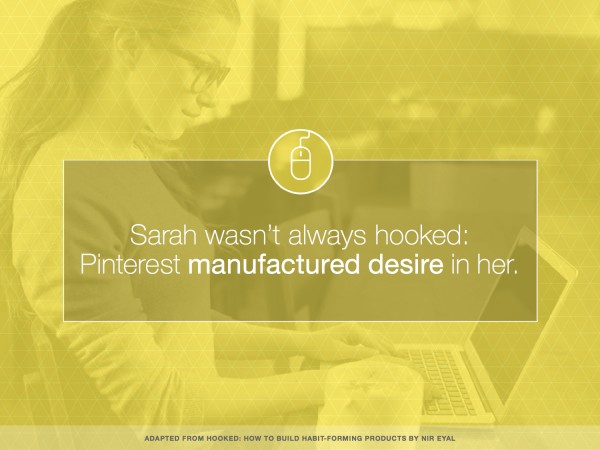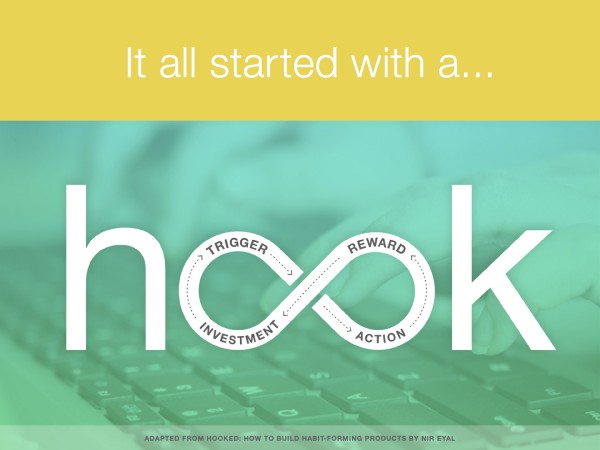I am one of those people who obsesses over the why and how when discussing any topic. Sometimes my incessant need to dig into a topic for a deeper understanding drives my friends and family nuts, but I can’t help it. I ask a lot of questions because I love knowing what makes people tick, as well as what makes products stick in the minds of users. My innate curiosity led me to discover one of my favorite books I have read so far this year, Hooked: How to Build Habit-Forming Products, by Nir Eyal.
Hooked is a guide to building habit-forming technology, written for product managers, designers, marketers, and startup founders. Within the pages of Hooked, Nir answers why and how for readers interested in leveraging psychology to drive engagement with an audience.
Just like product managers, presenters also need to build a connection with their audience and motivate people to take action. To captivate your audience with your next presentation, take inspiration from the 3 Hooked quotes included below.
3 Presentation Tips, Inspired by Hooked
1. Be A Painkiller
“Are you building a vitamin or painkiller?” is a common, almost clichéd question many investors ask founders eager to cash their first venture capital check. The correct answer, from the perspective of most investors, is the latter: a painkiller. – Nir Eyal
Presentation Tip:
Create slides that people need, instead of slides that people can easily skip, or sleep through.
To create slides that are painkillers, provide a step-by-step solution, answer a critical question, or if you can pull it off successfully, be entertaining and kill the pain of boredom.
Whatever you do though, don’t create slides that are just drops in an ocean of similar content. If too much similar content is already available, can your slides really reduce pain for viewers? Probably not, because the pain has likely already been resolved with the other existing content.
Once you find a unique angle for your presentation, don’t give your audience a watered down painkiller, give them a heavy duty dose by being bold with your content and design. For example, if you’re providing a solution as the painkiller, be thorough and thoughtful to ensure your viewers have all of the information they need to completely solve their problem.
2. Be Unexpected
Research shows that levels of the neurotransmitter dopamine surge when the brain is expecting a reward. Introducing variability multiplies the effect, creating a focused state, which suppresses the areas of the brain associated with judgment and reason while activating the parts associated with wanting and desire. – Nir Eyal
Presentation Tip:
Instead of producing slides that all adhere to the same style or layout, throw a few curveball slides into your presentation. As mentioned in the quote above from Hooked, variability can activate the parts of your brain associated with wanting and desire.
When practicing the art of variability, your slides should still be sufficiently consistent in style to look like they all belong to the same presentation, however you never want to bore your audience by being overly predictable.
To add variability to your presentation, try mixing up your approach to both content and design.
For example, look at the 2 slides below.
The first slide shown below might be labeled predictable because it has roughly the same amount of content, as well as the same content layout as many of the other slides in the deck.

The second slide (shown below) is somewhat of a curveball because it features a header and the one word hook, in a large, bold font, as well as four additional words integrated into the design in a surprising manner. The slide design is not likely what the viewer expected to see while clicking through the presentation, yet it still looks like it fits with the other slides in the deck. It is consistent, with a dash of variability.
* Complete presentation included at end of post

3. Be A Sparkplug
The trigger is the actuator of a behavior—the spark plug in the Hook Model. Triggers come in two types: external and internal. Habit-forming technologies start by alerting users with external triggers like an email, a link on a web site, or the app icon on a phone. – Nir Eyal
Presentation Tip:
For the many presenters who post presentations online, either for marketing, educational, or business purposes, this tip is especially for you. Share your presentations.
Once you upload your slides to SlideShare, get creative with your sharing methods, and share your deck frequently. Sharing your presentation will be your opportunity to capitalize on the power of external triggers.
Share your presentation in your newsletter. Embed it on your website. Feature it in your blog posts. Include your presentation in articles you contribute to other sites. Post it to all of your social media accounts. Add your deck to your LinkedIn profile. Write an article for your LinkedIn profile to promote your deck again on LinkedIn. Rinse. Repeat.
You get the idea, right? If you don’t share your presentation, you will struggle to achieve the results you desire because you are not triggering your audience. Instead you are hoping that viewers who fit within your target audience will stumble across your presentation. Be proactive and use external triggers. If your presentation was worth creating in the first place, it is worth sharing.
Conclusion
To create presentations that can captivate an audience, add some delightful surprises to your deck, and also be a painkiller. In addition, if you upload your presentations to SlideShare, create external triggers by sharing your presentation with your network.
For a quick overview of Hooked: How to Build Habit-Forming Products, check out the Ethos3 presentation included below.
Q&A with Nir Eyal
Leslie: Tell me about your relationship with public speaking.
Nir: I give private workshops and keynotes every other week. I speak at conferences related to technology and product design but most of my work is with companies who want to increase customer engagement with their product or service.
Leslie: Do you love or hate speaking in public?
Nir: I love what I do. The best part of my job is seeing teams have a breakthrough and get un-stuck. My job is to help companies understand how to make their product or service more engaging by understanding consumer psychology and user behavior.
Leslie: How do you prepare for your presentations?
Nir: To prepare for my presentations, I try to understand what is the key behavior my client is trying to change. Sometimes the behavior is a habit, like opening an app daily, and other times it’s not. It’s important to understand what kind of behavior the client is trying to help their users change before picking the right tools for the job — so to speak. I find presenting face-to-face gives me the opportunity to understand the nuances of my clients’ challenges.
Leslie: What are some of the most common questions about Hooked and how do you answer?
Nir: Q: What’s makes today’s technology so habit-forming?
A: In my book, I describe “Hooks” as experiences that connect users’ problems to a company’s solution with enough frequency to form a habit. Hooks are in all sorts of products we use with little or no conscious thought. Over time, customers form associations that spark unprompted engagement, in other words, habits. In the four step process I describe in Hooked, I detail how products use hooks to create these powerful associations.
Q: What is it about Twitter and Facebook that gets people hooked?
A: Like with all habit-forming products, use of the product is typically associated with an emotional pain-point, an existing routine, or situation. For example, what product do people use when they’re feeling lonely and seek connection? Facebook of course! What do we do when we feel uncertain? We Google! What about when we’re bored? Many people open YouTube, Pinterest, check sports scores, or stock prices — there are lots of products that address the pain of boredom.
Q: How did you get interested in studying habit-forming technology? Why did you write this book?
A: At my last company I worked at the intersection of gaming and advertising and I saw all kinds of tactics used to change customer behavior. I noticed that many people in the industry didn’t know why certain things worked or the psychological principles driving behavior — they just knew they were effective.
As an entrepreneur, I spent a lot of time banging my head against the wall trying to figure out why people were or were not engaging with the products my company built. Many designers experience this same frustration. Some products fly while others flop and we are never quite sure why.
When my company was finally sold, I decided I needed to understand user behavior better before starting another venture.
I wanted to find out what made some experiences habit-forming and that’s really been the central question with my work — how do products create habits? How do some companies draw users back again and again without wasting money on expensive advertising or spammy marketing tactics?
I spent years pouring over consumer psychology texts, behavioral economics books, and human-computer interaction research but didn’t find practical tools for building repeat engagement. So I decided to write the book I couldn’t find.
Q: Why do you believe “the world is becoming a more addictive place”?
A: Three macro-trends are making the world a potentially more addictive place. Companies are able to collect more data about user behavior, interactive technology is more accessible, and finally, the transfer of this data back and forth is happening faster than ever before. These three things — data, access, and speed — send users through Hooks faster and more frequently and therefore have increased the addictive potential of all sorts of products and services.
Q: You write, “habits are good for business.” How so? Why are customer habits important?
A: Habits are good for the bottom line for a number of reasons. Sustained engagement yields higher customer lifetime value, greater pricing flexibility, and can supercharge growth. In addition, customer habits defend against encroaching competitors. When users form routines and dependencies around using a particular product, the company can create tremendous value — just think of how habit-forming products like Facebook, Twitter, Google, and Instagram are.
Q: Do you find some technology too habit-forming? How do you fight bad habits?
A: As technology becomes more pervasive and persuasive, managing distractions and staying focused on the things that really matter is an increasingly important topic. To help me keep technology in its place and keep it from encroaching into areas of my life where doesn’t belong, I’ve ironically had to turn to new technologies.
I first started by understanding my own technology habits. I used the four phases of my Hook Model, which is at the core of habit-forming technology, to help me understand why I was doing certain behaviors. Then I sought to break the hooks I didn’t want.
For example, in an article I wrote titled “The Strange Sex Habits of Silicon Valley,” I detailed how I banished technology from my bedroom by using a timer to turn off the Internet every night at 10 o’clock. Another example is how I write. I use a program called Freedom to shut off my Internet for a given period of time while I concentrate. I think we are all going to have to become more aware of how we manage digital distractions.
About Nir Eyal: Nir has taught at the Stanford Graduate School of Business, and contributed articles to the Harvard Business Review, Forbes, The Atlantic, TechCrunch, and Psychology Today. Nir is also a frequent speaker at industry conferences and Fortune 500 companies.
For more insights on using psychology to change customer behavior, join his free newsletter and receive a free workbook.
